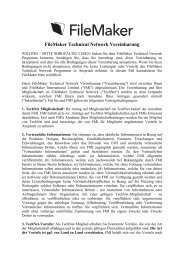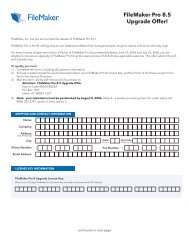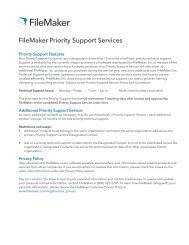Network Install Setup for FileMaker Pro 10 and
Network Install Setup for FileMaker Pro 10 and
Network Install Setup for FileMaker Pro 10 and
Create successful ePaper yourself
Turn your PDF publications into a flip-book with our unique Google optimized e-Paper software.
Setting up an MSI trans<strong>for</strong>m (Windows) 9<br />
The following table describes options users have when per<strong>for</strong>ming an assisted installation from the<br />
comm<strong>and</strong> line.<br />
To Instruct users to open a comm<strong>and</strong> window, then type<br />
<strong>Install</strong> a <strong>FileMaker</strong> product without a user interface (silent<br />
install)<br />
Uninstall a <strong>FileMaker</strong> product without a user interface<br />
(silent uninstall)<br />
<strong>Install</strong> a <strong>FileMaker</strong> product when required — advertise to<br />
current user (silent advertised install)<br />
<strong>Install</strong> a <strong>FileMaker</strong> product when required — advertise to<br />
all users (silent advertised install)<br />
Display a dialog box indicating whether the <strong>FileMaker</strong><br />
product was successfully installed<br />
Notes<br />
1 Pathname is the location of the installer directory you created on the networked volume.<br />
1 <strong>Install</strong>path is the desired location of the <strong>FileMaker</strong> product folder on the user’s computer. The path<br />
cannot contain spaces unless it is enclosed by quotation marks.<br />
1 The installer may reboot the computer if required.<br />
Setting up an MSI trans<strong>for</strong>m (Windows)<br />
"pathname\setup.exe" /s /v/qn<br />
"pathname\setup.exe" /s /x /v/qn<br />
"pathname\setup.exe" /s /v /ju<br />
"pathname\setup.exe" /s /v /jm<br />
"pathname\setup.exe" /s /v/qn+<br />
Display a progress bar <strong>and</strong> cancel button during installation "pathname\setup.exe" /s /v/qb+<br />
<strong>Install</strong> <strong>FileMaker</strong> <strong>Pro</strong> to a non-default location on your<br />
local machine<br />
<strong>Install</strong> <strong>FileMaker</strong> <strong>Pro</strong> Advanced to a non-default location<br />
on your local machine<br />
"pathname\setup.exe" /s /v"/qb+<br />
INSTALLDIR=\"installpath\<strong>FileMaker</strong> <strong>Pro</strong> <strong>10</strong>\""<br />
"pathname\setup.exe" /s /v"/qb+<br />
INSTALLDIR=\"installpath\<strong>FileMaker</strong> <strong>Pro</strong> <strong>10</strong> Advanced\""<br />
You can use an MSI trans<strong>for</strong>m (*.mst file) to provide personalization in<strong>for</strong>mation to the installer. For<br />
in<strong>for</strong>mation about Orca, MsiTran.exe, <strong>and</strong> other Windows installer development tools, see<br />
www.microsoft.com.<br />
1. Create a copy of the <strong>FileMaker</strong> <strong>Pro</strong>.msi file. For example, name the copy <strong>FileMaker</strong> <strong>Pro</strong> Assisted<br />
<strong>Install</strong>.msi.<br />
2. Use Orca (or similar software) to edit <strong>FileMaker</strong> <strong>Pro</strong> Assisted <strong>Install</strong>.msi. Set the personalization<br />
properties (AI_*) in the <strong>Pro</strong>perty table.<br />
See “Setting personalization properties” on page 11.<br />
3. Use an MSI trans<strong>for</strong>m generating tool, like MsiTran.exe, to create a trans<strong>for</strong>m. For example, to create a<br />
trans<strong>for</strong>m named Example.mst, type:<br />
msitran.exe -g "<strong>FileMaker</strong> <strong>Pro</strong>.msi" "<strong>FileMaker</strong> <strong>Pro</strong> Assisted <strong>Install</strong>.txt"<br />
Example.mst
















